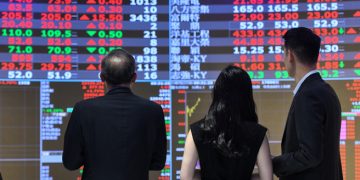Introduction
Financial markets are inherently influenced by a wide range of economic trends and factors that shape investor behavior, market performance, and the overall economic outlook. Editorial analyses and expert commentary often serve as a valuable lens through which to understand these trends, offering insights into the potential directions markets may take. Economic data and forecasts discussed in such analyses typically encompass key indicators, such as inflation rates, employment figures, GDP growth, fiscal and monetary policy shifts, and broader global events. These trends can either reinforce the status quo or signal potential shifts that could lead to significant changes in financial market dynamics.
In recent times, markets have been buffeted by numerous forces, including the aftermath of the COVID-19 pandemic, inflationary pressures, tightening of monetary policies by central banks, and geopolitical uncertainty. Given the current economic climate, it’s important to evaluate whether the prevailing trends forecast major transformations in the financial landscape. Are the economic indicators pointing towards a fundamental shift in market behavior? Or are they merely temporary disruptions?
This article aims to critically analyze the economic trends highlighted in editorial pieces and explore whether they suggest impending significant changes in the financial markets.
Section 1: Key Economic Trends Impacting Financial Markets
To understand whether the current economic trends point toward a transformative shift in financial markets, it’s essential to first break down the key trends influencing market behavior today. Experts often focus on the following aspects in their editorial analyses:
1.1 Inflation Pressures and Central Bank Responses
Inflation has emerged as one of the central economic concerns globally. In many countries, inflation rates have reached multi-decade highs, driven by a combination of supply chain disruptions, rising commodity prices, labor shortages, and the economic aftereffects of the COVID-19 pandemic. Editorial analyses have highlighted the persistence of inflation as a major issue for investors and policymakers alike.
Potential Market Impact:
- Tighter Monetary Policies: Central banks, particularly the U.S. Federal Reserve, have responded by raising interest rates to combat rising inflation. Higher rates typically lead to higher borrowing costs, which can dampen consumer spending and business investment. This shift has major implications for equity markets, particularly in sectors that rely on cheap financing, such as technology and real estate.
- Slower Growth: If inflation remains elevated, central banks may continue their tightening cycles, leading to slower economic growth. For investors, this could signal a change in market sentiment, as growth-oriented assets may underperform while value stocks or defensive sectors become more attractive.
- Interest Rate Sensitivity: The higher interest rates, while curbing inflation, can lead to increased market volatility. The focus shifts to how markets react to rate hikes, particularly in the bond markets, where rising yields might lead to corrections in asset prices.
1.2 Global Economic Slowdown and Recession Fears
The prospect of a global economic slowdown or even a recession has been a recurring theme in recent editorial analyses. As central banks raise rates to fight inflation, economic growth risks slowing down. Some experts worry that tightening policies could push economies into recession, particularly in developed markets where growth has already been sluggish.
Potential Market Impact:
- Stock Market Corrections: If global growth slows significantly or if a recession materializes, stock markets may experience heightened volatility and prolonged corrections. Investors may shift from growth stocks to more stable or defensive investments, such as utilities, healthcare, and consumer staples.
- Flight to Safety: In the face of recession risks, investors often seek safe-haven assets like government bonds, gold, and even the U.S. dollar. This dynamic could lead to shifts in portfolio allocations, with more capital flowing into lower-risk investments and out of more volatile sectors.
- Corporate Earnings Pressures: A global slowdown can hurt corporate earnings, especially for companies in cyclical industries such as consumer discretionary and industrials. As earnings growth stalls, market valuations could come under pressure, especially for high-growth companies that have been priced for future expansion.
1.3 Geopolitical Tensions and Supply Chain Disruptions
Geopolitical events such as the Russia-Ukraine conflict, trade tensions between the U.S. and China, and disruptions in global supply chains have been prominently discussed in recent economic analyses. These events have had significant implications for global markets, leading to supply shortages, rising commodity prices, and uncertainty about global trade routes.
Potential Market Impact:
- Commodity Price Volatility: Geopolitical events often result in supply-side shocks, which can drive commodity prices higher. The Russia-Ukraine war, for instance, has disrupted energy and grain supplies, creating inflationary pressures globally. In response, commodity-based stocks, particularly in the energy sector, might experience gains, while industries relying on these commodities face rising input costs.
- Market Volatility and Risk Aversion: Geopolitical uncertainties often cause market volatility. Investors may retreat to risk-averse assets, and markets may experience sharp swings as news events unfold. Global markets are also sensitive to changes in trade policies, as tariffs and sanctions can alter the global economic landscape.
- Regional Disparities in Growth: Geopolitical tensions and supply chain disruptions can create imbalances between different regions. Countries less affected by geopolitical instability, such as those in Asia, may see more robust growth, whereas nations heavily impacted by supply chain shortages or geopolitical events may experience slower recovery or higher inflation.
1.4 Technological Advancements and the Digital Transformation
Another key trend discussed in editorial analyses is the ongoing digital transformation, with technology and innovation playing an ever-increasing role in reshaping global economies. From artificial intelligence (AI) and automation to renewable energy technologies and blockchain, technological advancements are driving significant changes in industries.
Potential Market Impact:
- Tech Sector Growth: Companies at the forefront of digital transformation are often seen as high-growth investment opportunities. The continued rise of technology stocks, particularly in cloud computing, cybersecurity, and AI, could reshape market dynamics. Despite potential short-term volatility, these sectors may offer long-term growth potential for investors.
- Disruption of Traditional Industries: As technology continues to advance, traditional industries such as manufacturing, retail, and finance may face significant disruption. This could lead to shifts in market leadership, with technology-driven sectors taking a more prominent role in economic growth and financial market performance.
- Investing in Innovation: Experts often advise investors to position their portfolios toward sectors and companies benefiting from innovation. With the rise of the green economy, clean energy, electric vehicles, and biotech, investors may increasingly focus on companies that offer sustainable and technologically advanced solutions.

Section 2: Does Current Economic Analysis Point to Major Market Shifts?
Now that we’ve highlighted the key trends impacting the financial markets, it’s important to assess whether these trends suggest a major shift in the broader financial landscape or if they are merely cyclical fluctuations.
2.1 Inflation and Monetary Policy Shift: A Structural Change?
Inflation, combined with central bank rate hikes, suggests a possible long-term shift in financial markets. If inflation remains persistent, it could signal the end of the era of ultra-low interest rates that has characterized financial markets since the 2008 global financial crisis. Such a shift could fundamentally change the way investors approach asset allocation, as traditional stock and bond market dynamics might no longer apply in the same way.
- Repricing of Risk: The current rate hiking cycle could lead to a “repricing” of risk across asset classes. If inflation continues to erode purchasing power, fixed-income securities might struggle to deliver the returns they once did, leading to a potential shift in portfolio composition toward real assets such as commodities, real estate, or inflation-protected securities (TIPS).
- Shift to Value Over Growth: With higher interest rates, investors may favor value stocks over growth stocks. The tech sector, which has traditionally benefited from low rates, may see slower growth, while sectors like energy, materials, and utilities could perform better. If these shifts persist, we may see a prolonged transformation in market leadership.
2.2 Geopolitical Risks and Supply Chain Shocks: A Structural Disruption?
The impact of geopolitical tensions on global markets is another indicator of potential long-term shifts. The Russia-Ukraine conflict has exposed vulnerabilities in global trade networks, and experts suggest that the world may be entering a phase of “deglobalization,” where countries increasingly focus on self-sufficiency or diversify their supply chains to reduce dependency on politically unstable regions.
- Decoupling of Global Economies: As countries seek to reduce reliance on specific trading partners, there may be a structural change in the way the global economy functions. This could lead to regional shifts in market performance, as certain regions may benefit from supply chain diversification while others may struggle with higher costs and trade barriers.
- Reshaping of Global Energy Markets: The energy crisis caused by geopolitical tensions could lead to long-term changes in the global energy landscape. With a greater emphasis on energy security and sustainability, renewable energy investments could become more attractive, potentially driving a shift in the energy market and affecting industries globally.
Section 3: Conclusion
The economic trends highlighted in editorial analyses do indeed point toward significant shifts in the financial markets, although the extent and nature of these shifts will depend on how various factors evolve in the coming years. The ongoing battle with inflation, central bank responses, geopolitical risks, and technological innovation all signal potential structural changes that could transform investment strategies and market dynamics.
Investors will need to adapt to these changes by rethinking traditional investment approaches, diversifying their portfolios, and closely monitoring the evolving economic landscape. While volatility and uncertainty are inevitable, they also present opportunities for those who can correctly interpret and navigate these trends.
































